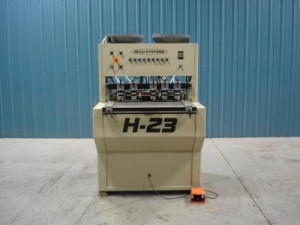 Like most modern machinery whose efficiency we take for granted, it wasn’t that long ago that commercial woodworking machinery didn’t offer the range of function and high output necessary to run a high production woodworking company. But yesterday’s woodworking machines weren’t exactly inefficient, either. In fact, at least three of them are still in use today, their invention ushering in America’s commercial woodworking industry.
Like most modern machinery whose efficiency we take for granted, it wasn’t that long ago that commercial woodworking machinery didn’t offer the range of function and high output necessary to run a high production woodworking company. But yesterday’s woodworking machines weren’t exactly inefficient, either. In fact, at least three of them are still in use today, their invention ushering in America’s commercial woodworking industry.
The Circle Saw Ushers in Commercial Woodworking Machinery
First patented in 1777 to Samuel Miller of Southampton, the circle saw was in use as early as 1427 by sawmills in Breslau. But despite the saw’s superior cutting speed and accuracy, its introduction caused rioting by woodworkers who feared that sawmilling—a phenomenon that grew up around the circle saw—would jeopardize their business by offering lower prices. Thanks to angry woodworkers, England’s first sawmills would go up in flames before they could profit from the circle saw. However, aided by the government, James Stanfield was successful in establishing England’s first lasting sawmill shortly before 1780.
The circle saw was the first truly “commercial” tool for woodwork, as it allowed sawmills to operate in a fashion similar to today’s large woodworking companies, where superior production is the result of superior technology. The circle saw birthed the sawmill, but another machine that would become just as important was on its way: the planing machine. The first planing machine patent was granted in 1776, but its crude construction kept it from use until 1827, when Malcolm Muir, of Glasgow, improved upon the original design for the purpose of producing floorboards, a successful endeavor that surely made Muir a fortune.
At a time when carpeting was still a luxury of the rich, Muir’s planer was a boon to the house building business. But his machine would soon receive an upgrade from American, John Butler, in 1847 that expanded its use. Unfortunately for Butler, his machine wouldn’t be found in sawmills for another two decades, its sale prohibited by the patent of William Woodworth, an American who invented had an inferior planing machine years earlier. Shortly before Woodworth’s death, he reportedly sold his patent for $5,000, a considerable sum at the time, but a pittance compared to what Butler would receive, as sawmills across America implemented his machine.
The final invention that officially began America’s commercial woodwork industry was the moulder, originally pioneered by C.B. Rogers, of Connecticut, in the late 1840’s, and vastly improved by H.B. Smith, of Massachusetts, in the late 1860’s. Once sawmills adopted the moulder, America’s commercial woodwork industry was born. By the late 1870’s, three machines that were required of the successful sawmill were circle saws, planing machines, and moulders. And the same is true of today’s high production woodworking companies.




